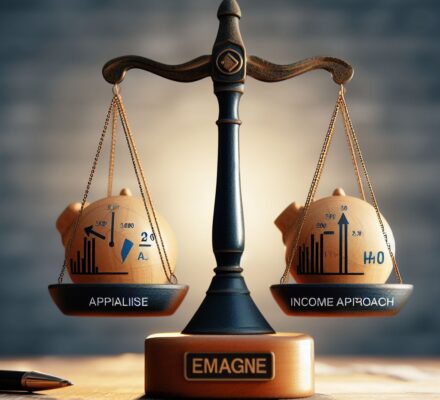Did you know that calculating fair market value is crucial to successful 1031 exchanges? Expert insights can help you navigate the complex world of determining property worth.
In this article, we break down key factors affecting fair market value and explore methods and appraisal techniques to accurately evaluate your assets.
Gain the knowledge you need to make informed decisions and maximize the benefits of your 1031 exchange.
Key Takeaways
- Fair Market Value (FMV) is the price an asset would sell for on the open market between a willing buyer and a willing seller.
- Location, condition of the property, income potential, and desirability of the location are key factors affecting fair market value.
- Methods for calculating fair market value include the Sales Comparison method, Income Capitalization method, and Cost Approach.
- Consulting with a qualified real estate professional or appraiser is important for accurate valuation and appraisal techniques in a 1031 exchange.
Understanding Fair Market Value
To understand Fair Market Value in a 1031 Exchange, you need to know how it’s calculated. Fair Market Value (FMV) is the price an asset would sell for on the open market between a willing buyer and a willing seller, both parties having all relevant information. In the context of a 1031 Exchange, FMV is crucial in determining the value of the relinquished property and the replacement property. The calculation of FMV involves analyzing various factors such as comparable sales, income potential, market conditions, and the property’s physical characteristics.
To determine FMV, a qualified appraiser is often hired to provide an unbiased assessment. The appraiser analyzes recent sales of similar properties in the area, taking into account factors like age, condition, location, and any unique features. They also consider income generated by the property and prevailing market conditions. The appraiser then applies appropriate valuation methods, such as the sales comparison approach, income approach, or cost approach, depending on the nature of the property.
It is important to note that FMV isn’t a fixed value, but rather a range within which a property can reasonably be expected to sell. By understanding how FMV is calculated, you can make informed decisions in your 1031 Exchange and ensure that you comply with the IRS regulations.
Key Factors Affecting Fair Market Value
The key factors that affect the Fair Market Value in a 1031 Exchange include the property’s location, condition, and income potential. These factors play a crucial role in determining the value of a property and can significantly impact the success of a 1031 exchange transaction.
Location is a critical factor that influences the fair market value of a property. The desirability of the location, proximity to amenities, transportation, and the quality of the neighborhood can all contribute to higher property values. Properties located in prime areas with high demand often command higher prices and are more likely to appreciate over time.
The condition of the property also affects its fair market value. A well-maintained property with updated features and modern amenities will generally have a higher value than a property in poor condition. Buyers are willing to pay a premium for properties that require minimal repairs or renovations, as it saves them time and money.
The income potential of the property is another significant factor. The potential rental income or revenue that the property can generate directly impacts its value. Factors such as rental rates, occupancy rates, and the potential for future growth in rental income can all influence the fair market value.
It is important to carefully consider these key factors when evaluating the fair market value of a property in a 1031 exchange. Conducting thorough research and analysis will help ensure that you make informed decisions and maximize the benefits of your exchange transaction.
Methods for Calculating Fair Market Value
You can calculate the fair market value of a property in a 1031 exchange using various methods. These methods provide a systematic approach to determining the value of your property accurately. Let’s explore some of the common methods used in calculating fair market value:
| Method | Description |
|---|---|
| Sales Comparison | Compares your property’s features and recent sales of similar properties to determine its value. |
| Income Capitalization | Estimates the value based on the property’s income potential, considering factors like rent and expenses. |
| Cost Approach | Calculates the value by determining the cost to replace the property, considering depreciation and improvements. |
Each method has its strengths and limitations, and the choice of method will depend on the specific circumstances of your property. It is advisable to consult with a qualified real estate professional or appraiser to ensure an accurate valuation.
Transitioning into the subsequent section on ‘Appraisal Techniques for 1031 Exchanges,’ understanding these methods is crucial as they form the foundation for the appraisal techniques used in the 1031 exchange process. By leveraging these techniques, you can confidently navigate the appraisal process and ensure a fair market value for your property.
Appraisal Techniques for 1031 Exchanges
Explore the appraisal techniques used in 1031 exchanges to determine the fair market value of your property.
When engaging in a 1031 exchange, it’s crucial to accurately determine the fair market value of your property to ensure compliance with IRS regulations.
One commonly used appraisal technique is the sales comparison approach. This method involves analyzing recent sales of comparable properties in the same market to estimate the value of your property. The appraiser considers factors such as location, size, condition, and amenities when selecting comparable properties.
Another technique is the income approach, which is particularly relevant for income-generating properties. This method involves estimating the property’s value based on its expected income stream. The appraiser considers factors such as rental rates, occupancy rates, operating expenses, and capitalization rates.
Additionally, the cost approach can be used, which estimates the value of the property based on the cost to replace it. This method takes into account factors such as construction costs, land value, and depreciation.
Ultimately, choosing the most appropriate appraisal technique depends on the nature of your property and the market conditions. Consulting with a qualified appraiser can help ensure an accurate determination of fair market value.
Considerations for Evaluating Fair Market Value
When evaluating fair market value in a 1031 exchange, it’s important to take into account various factors. These considerations play a crucial role in determining the value of the property involved in the exchange. Here are five key aspects to keep in mind:
- Location: The location of the property can have a significant impact on its fair market value. Factors such as proximity to amenities, transportation, and desirable neighborhoods can influence the value.
- Comparable Sales: Analyzing recent sales of similar properties in the area can provide valuable insights into the fair market value. Comparing the features, condition, and size of the subject property with these sales can help determine its value.
- Market Conditions: Understanding the current real estate market conditions is essential. Factors such as supply and demand, interest rates, and economic trends can affect property values.
- Physical Attributes: Assessing the physical characteristics of the property, such as its size, condition, and unique features, is crucial in determining its fair market value.
- Income Potential: For income-producing properties, evaluating the potential income and expenses associated with the property is vital. Factors such as rental rates, occupancy rates, and operating expenses can impact the property’s value.
Frequently Asked Questions
What Are the Potential Tax Benefits of a 1031 Exchange and How Does Fair Market Value Play a Role in This Process?
The potential tax benefits of a 1031 exchange are significant. Fair market value plays a crucial role in this process, as it determines the basis for calculating any potential capital gains taxes that may be deferred.
Are There Any Limitations or Restrictions on the Types of Properties That Can Be Exchanged Under a 1031 Exchange, and How Does Fair Market Value Affect These Limitations?
There are indeed limitations and restrictions on the types of properties you can exchange under a 1031 exchange. The fair market value plays a crucial role in determining if the properties meet these requirements.
How Does the Location of a Property Impact Its Fair Market Value, and What Factors Should Be Considered When Evaluating the Fair Market Value of Properties in Different Locations?
When evaluating the fair market value of properties in different locations, you should consider factors such as local market trends, neighborhood amenities, proximity to schools and transportation, and the overall desirability of the area.
What Are Some Common Mistakes or Pitfalls to Avoid When Calculating Fair Market Value in a 1031 Exchange, and How Can These Be Mitigated?
When calculating fair market value in a 1031 exchange, avoid common mistakes and pitfalls. Mitigate these by conducting thorough research, utilizing professional appraisers, considering all relevant factors, and staying updated on market trends.
Can Fair Market Value Be Subjective or Open to Interpretation, and if So, How Can Investors Ensure That They Are Accurately Determining the Fair Market Value of Their Properties?
Determining fair market value can be subjective. To accurately assess your property, employ a certified appraiser or conduct market research. Ensure objectivity by using reliable data and considering multiple factors.




